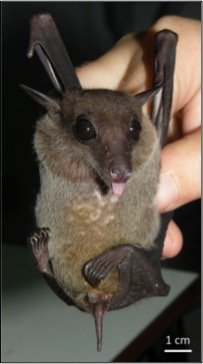The floral bat lure dimethyl disulphide does not attract the palaeotropical Dawn bat
DOI:
https://doi.org/10.26786/1920-7603(2015)19Abstract
In the neotropics, dimethyl disulphide (DMDS) is innately attractive to flower-visiting bats, and acts as a powerful bat lure in the scent bouquets of many bat-pollinated flowers. At first, DMDS appeared to be part of a general bat pollination syndrome. However, DMDS is absent in many bat-pollinated flowers of West Africa, and it is unclear whether palaeotropical flower-visiting bats are also attracted to it. Furthermore, DMDS was previously observed in neotropical, but not palaeotropical, populations of Ceiba pentandra (Malvaceae, Bombacoideae). We tested for an attraction to DMDS in the most common flower-visiting bat in Thailand, the dawn bat Eonycteris spelaea. We gave bats choices of Ceiba pentandra flowers, where one random flower was scented with DMDS. Rather than preferring the DMDS-treated flower, 21 of 22 bats chose an untreated flower, showing no attraction to DMDS. Alongside past evidence, this result suggests that the role of DMDS in bat pollination syndromes may result from an adaptive convergence that is limited to the neotropics. This hypothesis could be tested through comparative studies of (1) attraction across bats, (2) floral DMDS presence across bat-pollinated plants in Asia, and (3) floral DMDS measures across New and Old World populations of Ceiba pentandra.
Downloads
Published
How to Cite
Issue
Section
License
Copyright (c) 2015 Gerald G Carter, Alyssa B Stewart

This work is licensed under a Creative Commons Attribution 4.0 International License.
JPE is an open access journal which means that all content is freely available without charge to the user or his/her institution.
Authors who publish with this journal agree to the following terms:
1) Authors retain copyright and grant the journal right of first publication with the work simultaneously licensed under a Creative Commons Attribution License that allows others to share the work with an acknowledgement of the work's authorship and initial publication in this journal.
2) Authors are able to enter into separate, additional contractual arrangements for the non-exclusive distribution of the journal's published version of the work (e.g., post it to an institutional repository or publish it in a book), with an acknowledgement of its initial publication in this journal.
3) Authors are permitted and encouraged to post their work online (e.g., in institutional repositories or on their website) prior to and during the submission process, as it can lead to productive exchanges, as well as earlier and greater citation of published work (See The Effect of Open Access).
To assure a broader targeted audience, content will be included into databases (such as EBSCO) and directories (such as DOAJ).











